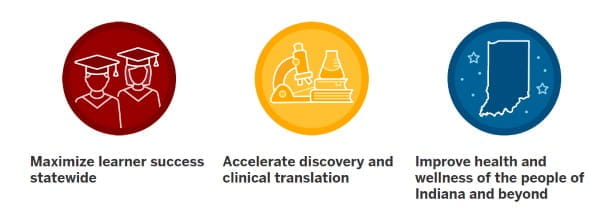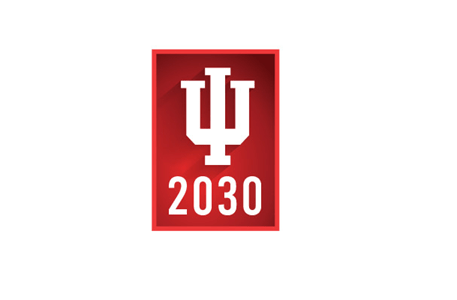Dear Colleagues,
Founded in 1903, Indiana University School of Medicine has a long history of innovation and excellence in medical education, research and clinical care—a tradition that continues as we look toward the future and our new IU School of Medicine 2030 Strategic Plan.
The new strategic plan for IU School of Medicine, part of the IU 2030 Strategic Plan, will be the roadmap for the school to advance excellence in all of its missions while supporting IU’s strategic goals of Student Success and Opportunity, Transformative Research and Creativity, and Service to Our State and Beyond. We have connected these goals to three pillars, which together represent a strong commitment to the state of Indiana, our learners, our hospital and industry partners, and—most importantly—our patients.

Explore IU School of Medicine's Strategic Plan
The IU School of Medicine plan was made possible through the dedication of hundreds of faculty, staff and learners across our nine campuses. As we worked collectively to develop a plan for the School of Medicine, several themes emerged—all of which we have incorporated into the plan’s three pillars.
- Our core values of excellence, respect, diversity, integrity and cooperation represent how we will work together, and need to be reinforced at every opportunity.
- We must address the vitality of our people, including faculty, staff and learners. We have a responsibility to do all we can to prevent burnout, address mental health challenges, ensure the availability of professional development, and recognize the accomplishments of community members.
- Bidirectional communication with our faculty, staff and learners and broader community (including over 20,000 living alumni) must be a priority to clarify professional roles, goals and responsibilities and to ensure all voices in our community are heard.
- Whether we’re improving outcomes for patients, graduation rates for our learners, or the climate in the school, we will use data to make better decisions. We will identify what data is most significant and useful, create systems for gathering and analyzing that data and most importantly act on that data.
- The School of Medicine must be a diverse place, reflecting the people in our community—a place where all are welcomed, included, supported and empowered to be their best. By promoting diversity and equity within the school and in the communities we serve we will be more successful in our mission of improving health for all.
Our executive leadership team has begun shaping our approach to plan execution—incorporating community input, establishing reporting mechanisms and ensuring our shared accomplishments are recognized. Planning efforts will continue through July, preparing the school to begin the new academic year with a clear and robust implementation plan.
I want to highlight the hard work of our co-chairs Michelle Artmeier, Dr. David Wallace and Dr. Sam Yeap who helped gather input from countless members of our community as well as those outside the school. Together with our executive associate deans, Dr. Patricia Treadwell as special advisor to the dean on diversity affairs, and project manager Katherine Eessalu, this team deserves our thanks for bringing the plan to its current form.
I am excited to work with all of you to realize this ambitious vision for the next few years. I am confident that together, we will continue the IU School of Medicine’s tradition of excellence in medical education, care and research.
With gratitude,

Jay L. Hess, MD, PhD, MHSA
Executive Vice President for University Clinical Affairs
Dean of the School of Medicine
Indiana University
